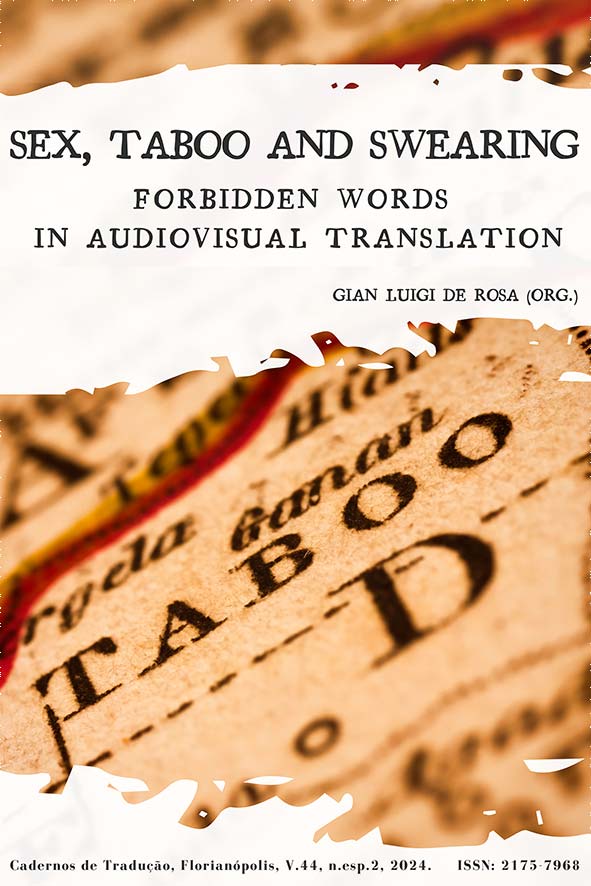Sex, taboo, and swearing: Forbidden words in audiovisual translation
DOI :
https://doi.org/10.5007/2175-7968.2024.e99138Résumé
Presentation of the special issue Sex, Taboo, and Swearing: Forbidden Words in Audiovisual Translation.
Références
Allan, K., & Burridge, K. (1991). Euphemism & Dysphemism: Language Used as Shield and Weapon. Oxford University Press.
Allan, K., & Burridge, K. (2006). Forbidden Words: Taboo and the Censoring of Language. Cambridge University Press.
Ávila-Cabrera, J. J. (2013) Subtitling multilingual films: The case of Inglourious Basterds. RAEL: Revista Electrónica de Lingüística Aplicada, 12, 87–100.
Ávila-Cabrera, J. J. (2014). The Subtitling of Offensive and Taboo Language: a Descriptive Study. [Tese de doutorado]. Universidad Nacional de Educación a Distancia.
Ávila-Cabrera, J. J. (2020). Profanity and blasphemy in the subtitling of English into European Spanish: Four case studies based on a selection of Tarantino’s films. Quaderns. Revista de Traducció, 27, 125–141. https://doi.org/10.5565/rev/quaderns.11
Ávila-Cabrera, J. J. (2023). The Challenge of Subtitling Offensive and Taboo Language into Spanish: A Theoretical and Practical Guide. Multilingual Matters.
Azzaro, G. (2005). Four–Letter Films. Taboo Language in Movies. Aracne.
Basso, R. M., & Souza, L. M. de. (2020). Puta: a sintaxe e a semântica de um controverso intensificador. Diadorim, 22(2), 528–556. https://doi.org/10.35520/diadorim.2020.v22n2a34290
Beers Fägersten, K. (2012). Who’s Swearing Now? The Social Aspects of Conversational Swearing. Cambridge Scholars Publishing.
Bruti, S., & Vignozzi, G. (2024). Vulgarization or non-vulgarization in dubbing from English into Italian? Insights from Netflix TV series. Cadernos de Tradução, 44(Special Issue 2), 1–20. https://doi.org/10.5007/2175-7968.2024.e99173
Buffagni, C. (2024). Aggressive speech acts or expressions of friendliness? Translating taboo words in Fatih Akins’ Soul Kitchen (2009) into Italian subtitles. Cadernos de Tradução, 44(Special Issue 2), 1–23. https://doi.org/10.5007/2175-7968.2024.e99177
Byrne, E. (2017). Swearing Is Good for You: the Amazing Science of Bad Language. Profile Books.
Campos, G. C. (2024). Tradução, insultos e streaming: um estudo de caso. Cadernos de Tradução, 44(Special Issue 2), 1–21. https://doi.org/10.5007/2175-7968.2024.e99610
De Laurentiis, A., & Marra, L. (2024). Sexo, lengua y traducción: análisis de los subtítulos en español peninsular y en italiano de la serie Sex Education. Cadernos de Tradução, 44(Special Issue 2), 1–16. https://doi.org/10.5007/2175-7968.2024.e99264
De Rosa, G. L. (2022). La sottotitolazione del turpiloquio nelle fiction e serie TV: il caso Irmandade. In M. S. Felici (Org.), Glottodidattica della lingua portoghese in diacronia e sincronia (pp. 99–116). Tuga edizioni,
De Rosa, G. L. (2024). Estratégias tradutórias e plataformas Narrowcasting: legendando a linguagem tabu em seriados portugueses e brasileiros. Cadernos de Tradução, 44(Special Issue 2), 1–31. https://doi.org/10.5007/2175-7968.2024.e99139
Díaz Cintas, J. (2001). Sex, (sub)titles and videotapes. In L. Lorenzo García & A. M. Pereira Rodríguez (Orgs.), Traducción subordinada II: el subtitulado (inglés – español/galego) (47–67). Universidade de Vigo.
Garzelli, B. (2024). Cortometrajes, habla soez y subtitulación: los casos de Diez minutos (2004) y Dime que yo (2008). Cadernos de Tradução, 44(Special Issue 2), 1–16. https://doi.org/10.5007/2175-7968.2024.e99178
Ghiselli, S. (2024). A quantitative analysis of racist epithets referring to Italians and their translations in movie subtitles: The case of Wop, Eyetie and Goombah. Cadernos de Tradução, 44(Special Issue 2), 1–18. https://doi.org/10.5007/2175-7968.2024.e99464
Jay, T. (1980). Sex Roles and Dirty Word Usage. A Review of the Literature and a Reply to Haas’, Psychological Bulletin, 88(3), 614–621. https://doi.org/10.1037/0033-2909.88.3.614
Jay, T. (1992). Cursing in America. A Psycholinguistic Study of the Use of Dirty Language in the Courts, in the Movies, in the Schoolyears and on the Streets. John Benjamins.
Jay, T. (2000). Why we curse: a neuro-psycho-social theory of speech. John Benjamins.
Ljung, M. (2011). Swearing. A Cross-Cultural Linguistic Study. Palgrave Macmillan.
Lupetti, E. (2024). Doppiare parole tabù: insulti e imprecazioni nella serie tv Lupin. Cadernos de Tradução, 44(Special Issue 2), 1–16. https://doi.org/10.5007/2175-7968.2024.e99721
Martinez, S. L. (2024). Palavrões e turpilóquios à vontade: os serviços de streaming e a atualização das normas de tradução para legendagem. Cadernos de Tradução, 44(Special Issue 2), 1–14. https://doi.org/10.5007/2175-7968.2024.e99146
McEnery, A. (2006). Swearing in English. Bad Language, Purity and Power from 1586 to the Present. Routledge.
McEnery, A., & Xiao, Z. (2000). Swearing and Abuse in Modern British English. In B. Lewandowska-Tomasczyk & P. Melia, (Orgs.). Practical Application of Language Corpora (37–48). Peter Lang.
McEnery, A., & Xiao, Z. (2003). Fuck Revisited. Corpus Linguistics, 28(31), 504–512.
McEnery, A., & Xiao, Z. (2004). Swearing in Modern English: the Case of Fuck in the BNC. Language and Literature, 13, 235–268.
Pavesi, M., & Formentelli, M. (2019). Comparing insults across languages in films: Dubbing as cross-cultural mediation. Multilingua, 38(5), 563–582. https://doi.org/10.1515/multi-2018-0124
Pavesi, M., & Malinverno, A. L. (2000). Usi del turpiloquio nella traduzione filmica. In C. Taylor (Org.), Tradurre il cinema (pp. 75–90). EUT Edizioni Università di Trieste.
Rebollo-Couto, L., & Rilliard, A. (2024). Variación pragmática, traducción audiovisual y estrategias conversacionales para el doblaje: léxico coloquial y palabras tabús. Cadernos de Tradução, 44(Special Issue 2), 1–28. https://doi.org/10.5007/2175-7968.2024.e99158
Stapleton, K. (2000). Swearing and perceptions of the speaker: A discursive approach. Journal of Pragmatics, 170, 381–395.
Trudgill, P. (2000). Sociolinguistics: An Introduction to Language and Society. Penguin Group.
Villanueva-Jordán, I. (2024). Call them by their names: sexualidad, homoerotismo y traducción audiovisual. Cadernos de Tradução, 44(Special Issue 2), 1–25. https://doi.org/10.5007/2175-7968.2024.e99147
Xavier, C. (2024). Tradutores audiovisuais e o tabu: um estudo de atitudes relativas à tradução para legendagem na televisão portuguesa. Cadernos de Tradução, 44(Special Issue 2), 1–22. https://doi.org/10.5007/2175-7968.2024.e99685
Téléchargements
Publiée
Comment citer
Numéro
Rubrique
Licence
(c) Tous droits réservés Cadernos de Tradução 2024

Ce travail est disponible sous la licence Creative Commons Attribution 4.0 International .
Autores têm autorização para assumir contratos adicionais separadamente, para distribuição não exclusiva da versão do trabalho publicada nesta revista (ex.: publicar em repositório institucional ou como capítulo de livro, com reconhecimento de autoria e publicação inicial nesta revista).





















































